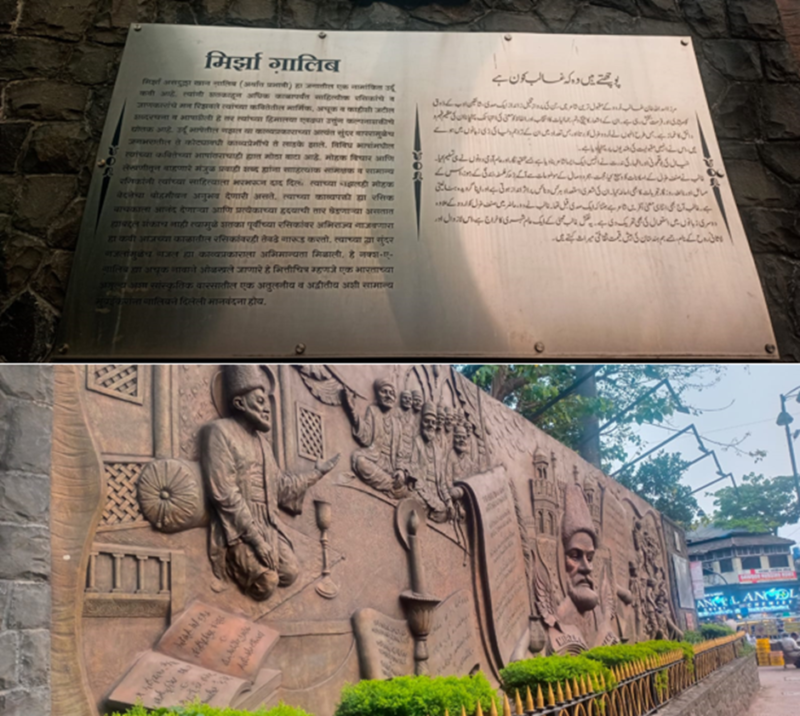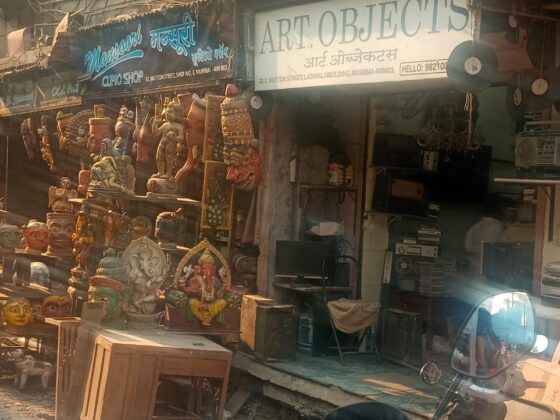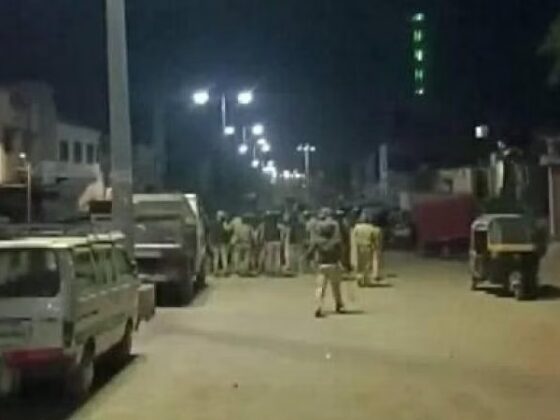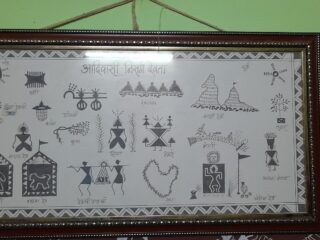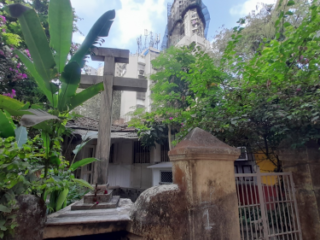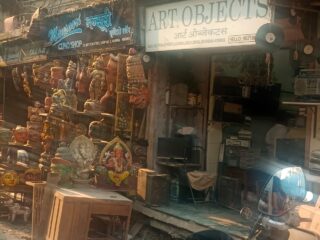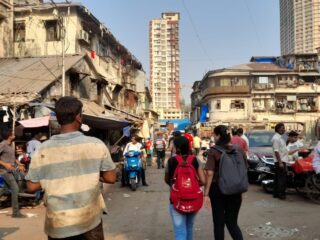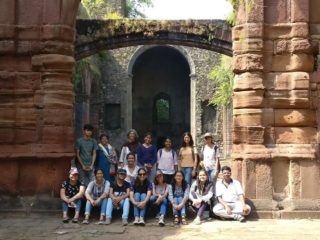Neha Dabhade
27/03/2023
“Bhendi Bazaar should not be known by Dawood Ibrahim but by Dawood Dalvi, a professor who taught humanities in London, not Chota Shakil but Shakil Badayuni, famous poet and song writer”, was the key take away from the cultural walk of Bhendi Bazaar named as Manto walk. The walk was organized by Centre for Study of Society and Secularism (CSSS) as part of its ‘Diversity in Mumbai’ Course conducted with students of Diploma of Social Work at Nirmala Niketan College. Adv. Zubair Azmi, Director of Urdu Markaz facilitated the walk. The visit to Bhendi Bazaar was an eye opener to the cultural treasure trove that Bhendi Bazaar is! Bhendi Bazaar boasts of some lofty names in the world of cinema, poetry and literature. Bhendi Bazaar was home to Manto, Kaifi Azmi, Mohammad Rafi, Majrooh Sultanpuri, Jan Nisar Akhtar, Sahir Ludhyanvi and Shakeel Badayuni. But unfortunately, in the popular imagination, Bhendi bazaar is synonymous with underworld and dreaded mafia – the Mafia has also been assigned a communal identity. Bhendi Bazaar is today mostly known as a Muslim majority area which was home to Dawood Ibrahim. In fact it is not considered a safe a locality by many to walk around. That it is historically important for its salient contribution to literature, cinema and arts is still a lesser known fact.
Bhendi Bazaar includes the areas of Mohammed Ali Road, Zakaria Masjid, Dongri, Nagpada, Madanpura and Mominpura. Interestingly, the students were told that there are a couple of theories explaining how Bhendi Bazaar acquired its name. One theory is that it is mentioned in the Maharashtra State Gazette that in the north west of Dongri there was a plantation of the ‘spesia populnia’ or ‘bhendi’ as we know it. Another theory is that there was a fire that broke out in 1803 at the British Fort Area and the residents were resettled in the area ‘behind the bazaar’. ‘Behind the bazaar’ somehow transformed into Bhendi Bazaar. Bhendi Bazaar over the decades not only has been an indispensable factor in nurturing artists and litterateurs but also is a bustling economic and trading hub- one of the major contributors to the financial capital of India.
The communities that made Bhendi Bazaar:
During the Manto walk, the group was introduced to a fascinating aspect of Bhendi Bazaar. The area was inhabited by Hindus, Muslims, Parsis and Jews. The area was home to a sizeable number of Jews in Mumbai. The area had a high concentration of Jews until the 1940s and 1950s. The Jews have contributed significantly to the cultural landscape of Mumbai. In Nagpada, there is a park called ‘Padmakar Tukaram Mane’ garden. This garden was once a Jew cemetery.
Interestingly, next to this garden there is a beautiful mural of Mirza Ghalib. At one time, as many as six synagogues dotted the stretch from Jacob Circle to Masjid. The relations between Jews, Parsis, Muslims and Hindus have been very cordial and has given rise to composite culture in the locality.
Bhendi Bazaar is home to the oldest Bene Israeli synagogue of Maharashtra- the Shaar Harahamin built in 1796. It was built by Samuel Ezikiel Diwekar, a Bene Israel himself who had served in the British Army against Tipu Sultan. The street on which the Synagogue is situated is named Samuel Street after him. In fact, the Masjid Bundar station is named after this synagogue which is referred to as ‘Mashid’ in the language of the local Bene Israel. The Marathi-speaking Bene Israelis lived in the villages and towns of the Konkan coast for hundreds of years. Their lore traces their history to seven couples being ship-wrecked off the Konkan coast at Navgaon some 2,200 years ago, when Jews faced persecution by the Seleucids in Palestine. The minuscule number of Bene Israelis in these villages assumed names indicating their places of residence by adding the suffix ‘kar’ to their village names.
The contribution of Jews to Hindi Cinema is notable. In an era where Hindu and Muslim women faced restrictions in pursuing careers in acting and dancing, Bollywood saw some iconic Jew actresses like Nadira who lived in Bhendi Bazaar. Similarly, in popular songs like ‘Mera naam chin chin chu’, the most of the dancers too were Jews. Other eminent names of Jew actors include Ruby Myers aka Sulochana, Ezra Mir, Esther Victoria Abraham aka Pramila, Rachel Hyam Cohen aka Ramola, David Abraham Cheulkar, writer Josef David Penkar, and director Hannock Isaac Samkar.
Apart from Bollywood, the Jew community has contributed seminally to Bombay historically. The Sassoon family is immortalized in Bombay by way of important institutions they have built. They built Kenesth Eliyahoo, the famous synagogue in South Mumbai. They also built Sassoon Docks, the location of a big open-air fish market, in 1875, and Sassoon Library, Mumbai’s first public library, a beautiful Venetian Gothic-style building that opened in 1847. Fittingly, a Jewish heritage walk is held on Sundays at Sassoon Docks. The Sassoons were Baghdadi Jews, whose patriarch, David Sassoon, fled to India in 1828 from Iraq by way of Iran and founded a business empire.
Architectural marvel:
One of the less explored gems of Bhendi Bazaar which was absolutely breath-taking was the Mughal Mosque or the Blue Mosque. Located in the heart of Bhendi Bazaar, the Mughal Mosque and its premises in characteristic striking blue tiles is distinctly Iranian in its influence. The Mosque is approximately 172 years old. After entering the premises of the Mosque, one feels transported to another era and place. Though located on a bustling street, full of vehicular traffic, the mosque offered an oasis of tranquillity. The gleaming pond and the manicured gardens inside the premises surrounded by a mosaic of blue colour tiles forming intricate designs is a sight to behold. The students were overwhelmed and taken in awe by its pure beauty. It’s perhaps the only Iranian mosque in Maharashtra.
Right next to the Blue Mosque, there is an Iranian Hamaam. The Hamaam, public bath, was functional for many years and a few years back the author was fortunate to visit it. However, unfortunately, the Hamaam is not functional anymore. Yet it remains one of the cultural and architectural attractions.
Wazir restaurant and Sarvi Restaurant:
Bhendi Bazaar, as mentioned above, is historic for its contribution to literature and music. Artists – famous and struggling, coming to Bombay from different parts of India and from diverse religious communities, all at some point in time, made Bhendi bazaar their home and was also inspiration for their work. Two locations in Bhendi Bazaar are particularly significant. One is the erstwhile Wazir Hotel and another is Sarvi restaurant. Hotel Wazir hosted some legendary artists. One of them was Mohammad Rafi. It is believed the Rafi’s fan, Mahendra Kapoor came to meet Rafi at the Hotel from half way across India. Sarvi Restaurant is equally iconic. Situated on the corner of Nagpada, this restaurant was a regular joint for Saadat Hasan Manto. He spent considerable time at the restaurant while he stayed at Bombay. In fact some of the characters in his work were inspired from real life people he met and saw in the restaurant. Manto spent a significant portion of his career in Bombay, where he worked as a writer for the Hindi film industry. His time in Bombay had a profound impact on his writing, and many of his most famous stories are set in the city. His portrayal of the city and its people were nuanced and complex, reflecting the contradictions and complexities of life in the rapidly changing city.
Saadat Hasan Manto’s writing is closely associated with the Partition of India in 1947, which resulted in the largest mass migration in human history and the deaths of hundreds of thousands of people. Manto’s own life was deeply impacted by the Partition. He chose to move to Pakistan after the Partition, but he was deeply critical of the violence and hatred that accompanied the separation of India and Pakistan. His writing during this period reflects the trauma and suffering experienced by the people who were affected by the Partition.
Manto’s stories from this period are marked by their brutal honesty and stark realism. He did not shy away from depicting the violence and horror of the Partition, nor did he hesitate to criticize the politicians and the leaders who were responsible for it. Some of Manto’s most powerful stories about the Partition include “Toba Tek Singh,” which depicts the confusion and absurdity of the Partition through the story of a man who refuses to leave his mental institution, and “Mozelle,” which tells the story of a young girl who is abducted during the violence that accompanied the Partition. Manto’s writing about the Partition is considered some of the most important literature to emerge from this tumultuous period in South Asian history. His work continues to be studied and appreciated by readers and scholars around the world
Contribution to Urdu and the movement to highlight and preserve:
Urdu and its heritage in Mumbai owe a great debt to Bhendi Bazaar. Bhendi Bazaar with its ecosystem of diverse cultural milieu and influx of artists from across the world nurtured Urdu. ‘Maktaba Jamia’ is an Urdu book shop of Jamia Millia Islamia located in Bhendi Bazaar. It is Mecca for Urdu lovers for the rare Urdu collections it boasts of. Urdu scholars and aficionados frequent this store for reading and referring to the treasures held by this store. The book store along with the artists like Manto have contributed to nurturing a rich language. Urdu considered as ‘foreign’ by certain political ideologies, has enriched literature and understanding of Indian society. Thus individuals who appreciate culture and this rich heritage strive to preserve and promote Urdu language. One of the initiatives taken by Azmi is the organizing of the ‘Bhendi Bazaar festival’. The first festival was organized in 2014, second in 2016 and the latest in 2023. The festival aims at celebrating the rich Urdu language and create a platform for young Urdu poets to showcase their talent. In 2023, Javed Akhtar was one of the prominent artists who inaugurated the festival. This coming together of talent – old and new is a literary treat for Urdu lovers and those who appreciate culture.
Shubhangi Pathak, one of the students said, “I would not have imagined myself walking the streets of Bhendi Bazaar. We were always told it is an area full of Muslims and it is filthy. I am glad that I was part of this visit. Being from Mumbai, I wasn’t aware of its significance. But now I know better”. This feeling resonated with most of the students who were part of the visit. Mumbai, the kaleidoscope of communities, culture, history, also had its fair share of conflicts. However, these conflicts and resulting violence and polarization can’t be allowed to overshadow the rich history and significant contribution it has made to the Mumbai that has evolved today. Bhendi Bazaar’s notorious reputation for its association with underworld dons has overshadowed its rich cultural and historical legacy. However, as highlighted in the Manto walk, Bhendi Bazaar has been a hub of literature, poetry, cinema, and arts, and a thriving economic and trading centre. The amicable relations between the diverse communities that have made Bhendi Bazaar their home have given rise to a composite culture that is a unique aspect of this locality’s identity. The focus is inevitably on the more infamous names from history but not the positive contributions which make this city inclusive, beautiful and complex. Such visits help us to live and indulge in a fascinating slice of history.



